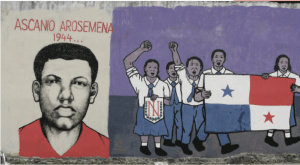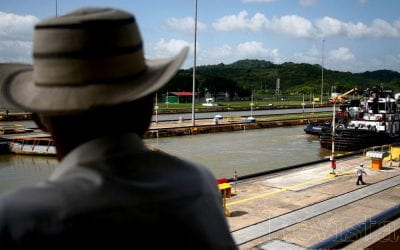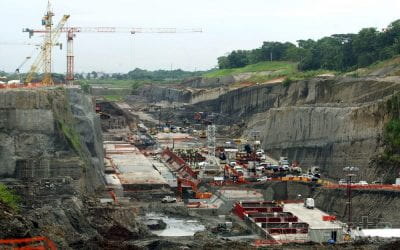A Tale of Two Flags
The Last Hurdle

A mural honors the high school students who demanded the return of sovereignty of the Panama Canal Zone. High school student leader Ascanio Arosemena was one of the Panamanians who died on January 9, 1964, now known as the Day of the Martyrs.
When in 1995 President Ernesto Pérez Balladares appointed me to head the commission responsible for the transition of the Panama Canal from U.S. to Panamanian hands, it never crossed my mind that yet another negotiation—unexpected at the time—loomed on the ho- rizon, over an issue that had been at the center of U.S.-Panamá relations for an entire century: flags.
It had been 18 years since President Jimmy Carter and General Omar Torrijos had signed a treaty recognizing Panamá’s full sovereignty over the canal by the end of the century, thus ending 75 years of confrontations. A new special federal agency, the Panama Canal Commission, was then to take over the operation of the canal for 20 years. Both countries engaged immediately in pursuing a seamless transition, a bi-national Board of Directors (five Americans and four Panamanians) was appointed to gradually transfer responsibilities once held by Americans to Panamanian personnel. Everything seemed to be on track and moving smoothly until a last minute glitch emerged.
The original U.S.-Panamá treaty was signed just 15 days after Panamá’s independence from Colombia. The United States was granted sovereign rights over a 50-mile-long, ten-mile-wide stretch of land known as the Panama Canal Zone: in perpetuity the use, occupation and control of a zone of land and land under
water for the construction maintenance, operation, sanitation and protection of [the] Canal…and all the rights, power and authority within the zone which the United States would possess and exercise if it were the sovereign of the territory within which said lands and waters are located to the entire exclusion of the exercise by the Republic of Panama of any such sovereign rights, power or authority (Articles II and III of the Hay- Bunau Varilla treaty).
Panamá grew economically as an independent nation during the follow ing decades. However, the treaty laid out that in the part of the Panamanian territory that was the Canal Zone only the U.S. flag should be flown. Citizens symbolically placed small Panamanian flags in the area, but they were unable to raise one on a flagpole until President Dwight Eisenhower authorized flying both flags on one location at the border that separated Panama City from the Canal Zone.
Nonetheless, discontent kept growing among Panamanian citizens, while Congress, the military and Zonians, as residents of the Panama Canal Zone were known, strongly opposed further changes. Eventually, on the advice of the State Department, President John F. Kennedy and President Roberto F. Chiari agreed that the Panamanian flag should be flown alongside with the U.S. flag in all non-military sites within the Canal Zone. An executive order was issued to this effect, but Zonians refused to comply. Their defiance was supported by outraged lawmakers and encouraged by a district court ruling in the Canal Zone stating that “the flying of two national flags side by side in a dis- puted territory for an undeclared purpose is a position of weakness that can lead but to further misunderstanding and discord” (Doyle v. Fleming). Clearly, Panamanians were not the only ones irked over the flag issue; the Zonians too felt that their sov- ereignty was in jeopardy. To make things worse they allowed the two flags to be raised in one isolated location, ignoring an order issued by the Canal Zone governor to the effect that neither flag should be raised.
On January 9, 1964, a group of high school students from the Instituto Nacional—located on the very street that used
to separate Panama City from the Canal Zone—decided to cross over with a Pana- manian flag demanding that it be raised in Balboa High School where, in violation of the executive order, only the U.S. flag was flying. School authorities and students turned them down; the Panamanian flag was torn, words led to pushing and shoving. The news about the torn flag spread like wildfire and riots broke out. By midafternoon hundreds of outraged Panamanians tried to storm into the Canal Zone, throwing stones and other objects. The Canal Zone Police and later the U.S. Army fired live bullets back. Twenty-two Panamanians were killed and more than 500 injured. President Chiari severed diplomatic relations with the United States, and Panamá thus became the only Latin American country to do so, to this date.
Three months later, President Lyndon Johnson agreed to negotiate a new treaty. Diplomatic relations were re-established., but it was more than 14 years before a new agreement could be reached. By dismantling the Canal Zone, the Torrijos-Carter treaty settled the flag issue once and for all. Not surprisingly, a full article (VII) of the treaty was devoted to the subject:
The entire territory of the Republic of Panama, including the areas the use of which the Republic of Panama makes available to the United States of America pursuant to this Treaty and related agreements, shall be under the flag of the Republic of Panama, and consequently such flag always shall occupy the position of honor.
But the treaty had to pass constitu- tional requirements in both countries: approval by two thirds of the U.S. Senate and a national referendum in Panamá. Advocates of the treaty in Panamá cam- paigned on a very effective slogan, more like a magic mantra: “only one territory, only one flag.” By a margin of 2 to 1 Panamanians approved the referendum. The vote was much closer in the U.S. Senate: only one more vote than the required 67.
The Torrijos-Carter treaty called for a 20-year transition period. During this time a constitutional amendment was drafted, as well as laws and regulations for the canal to operate properly when transferred to Panamá. Under the lead- ership of the chairman of the board of directors, Joe Reeder (1995-1998), at the time Under Secretary of the Army, the United States fully and enthusiasti- cally cooperated with Panamá in mak- ing preparations. As head of the Pana- manian team, and later as the board’s vice-chairman, I believe we honored our mission statement, truly living up to our motto, One Team One Mission.
During the transition period (1979- 1999), both flags flew side by side in all public buildings and government facilities, including military bases. This showed there was a joint administration of the operation and defense of the canal, and eventually the canal would be hand- ed over to Panamá as had been happening gradually with the military bases. The treaty specified the day and hour in which the handover would take place, putting an end to a century-long special relationship, both fruitful and tumultuous: noon, Panamá time, December 31, 1999.
But as the day approached and celebrations were planned, flags again took the center of a new and final negotiation. It had to do with the ceremony marking the end of the treaty and of the U.S. military presence in Panamá. On behalf of the Panamanian members of the Board of Directors of the Panama Canal Commission, I proposed what I thought was a very simple ceremony. In fact we never imagined it would trigger a controversy at a time when Panamanians and Americans alike were congratulating themselves on the success of the transition. To symbolize the ending of the U.S. administration and the begin- ning of the Panamanian one, it seemed only natural that the U.S. flag be lowered and the Panamanian flag be raised in its place in front of the Panama Canal’s administration building. To our surprise the proposal was vehemently rejected by U.S. members of the board and by diplo- matic and military officials. They feared that it could be regarded as surrendering rather than a celebration, followed by booing and mocking by the large crowd expected to attend. I argued that that the mood would not be one of revenge, let alone mockery, but one of friendship and gratitude. The response was no.
We then tried, just hours before the ceremony was to take place, another suggestion to overcome the apparent impasse: the U.S. flag was to be lowered
and the Panamanian flag raised simulta- neously. That way there would be no risk of booing, and the timing would also quite accurately reflect what was occurring at the moment, the end of the U.S. administration and the beginning of the Panama- nian one. The response was still no.
Since the treaty was still in effect, U.S. officials had the last word. They decided that the U.S. flag would be lowered the day before, never to be raised again. So at 5 p.m. on December 30, 1999, the flag was lowered in a sober and solemn ceremony attended only by diplomatic and military personnel, and of course by the Panamanian board members and high- ranking executives of both countries serv- ing at the Panama Canal Commission.
The following morning, for the first time in almost a hundred years, the Panamanian flag flew alone in the canal area. It was the end of an era of peaks and val- leys, friendship and controversy, prosperity and mourning. A tale of two flags with a happy ending when the slogan became real and achieved the dream of several generations: Only one territory, only one flag.
Spring 2009, Volume VIII, Number 3
Jorge Ritter is a Panamanian lawyer, writer, columnist and lecturer. He served as Ambassador to the UN, Minister of Justice and Minister of Foreign Affairs. As Minister for Canal Affairs and member of the Board of Directors of the Panama Canal Commission he was intimately involved in the process of transferring the Canal to Panamá.
Related Articles
Who Remembers Panamá?
There was a time, many decades ago, when the Isthmian country of Panamá—dividing the Americas—made near daily headlines from Canada to Argentina…
The Story That Panamá Decided to Write
A few days prior to the date set for the transfer of the Panama Canal from the United States to Panamá, a reporter from a U.S. news network asked me, “Mr…
The Panamanian Novel
Pueblos perdidos, the novel which earned Gil B. Tejeira Panamá’s Miró Literary Prize for 1963, tells the story of Gatún Lake, at the time the largest artificial…




